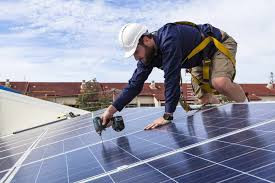views
The solar photovoltaic installations market is a vital component of the global transition toward sustainable energy. Driven by technological advancements, falling costs, and environmental imperatives, solar PV has gained considerable momentum worldwide. However, despite strong market potential and growing awareness, several hindrances continue to obstruct the smooth growth and scalability of solar PV installations. These barriers are multifaceted, encompassing economic, technical, regulatory, and social dimensions.
This article outlines the key hindrances affecting the solar PV installations market and explores how they are limiting the pace of adoption and long-term development.

High Initial Investment Costs
One of the foremost challenges in the solar PV installations market is the high capital expenditure associated with system deployment. Although module prices have declined over the years, the total cost—including equipment, installation labor, permits, and balance-of-system components—can still be prohibitive for many homeowners, small businesses, and rural communities.
The lack of flexible financing mechanisms and limited access to credit in many parts of the world exacerbate this problem. In regions where subsidies and tax incentives are absent or inadequate, the burden of upfront costs often discourages potential adopters from investing in solar energy solutions.
Inconsistent Government Policies
A stable and supportive regulatory environment is essential for the growth of any industry, and solar PV is no exception. However, inconsistent or abruptly changing government policies create uncertainty and disrupt market confidence. Sudden changes in net metering regulations, feed-in tariffs, or renewable energy mandates can halt projects mid-way or render them financially unfeasible.
In some regions, bureaucracy and red tape slow down the permitting process, delaying project timelines. The absence of streamlined and transparent approval procedures discourages both domestic and foreign investment, making it difficult to maintain sustained growth in the sector.
Inadequate Grid Infrastructure
The integration of solar PV into existing electrical grids presents major technical challenges, particularly in regions with outdated or poorly maintained infrastructure. Solar power is variable and intermittent, creating issues with voltage regulation and frequency stability on the grid. Many traditional power systems were not designed to handle decentralized, bidirectional energy flows.
The lack of grid modernization—such as smart grid technologies, advanced metering, and energy management systems—prevents effective assimilation of large-scale solar projects. In rural and remote areas, grid connectivity is sometimes non-existent, requiring off-grid systems that are often more expensive and less reliable.
Energy Storage Limitations
The inability to store solar energy efficiently remains one of the largest barriers to full solar PV integration. Without effective energy storage, excess electricity generated during the day cannot be saved for use during peak demand periods or at night, reducing the reliability and appeal of solar installations.
Battery storage technologies like lithium-ion are available but still costly, especially for residential and small commercial users. Furthermore, the infrastructure for large-scale energy storage, such as grid-scale battery farms, is underdeveloped in many countries, slowing the adoption of solar PV as a primary energy source.
Land and Space Constraints
Large-scale solar PV installations require vast land areas, which can be difficult to secure, particularly in densely populated or agriculturally valuable regions. Land acquisition is often complicated by legal disputes, zoning restrictions, and environmental regulations.
Additionally, community resistance due to concerns about land use, aesthetics, and ecosystem disruption can result in project delays or cancellations. In urban settings, limited rooftop space and shading issues reduce the potential for residential solar installations, requiring creative solutions like building-integrated photovoltaics or community solar programs.
Supply Chain Vulnerabilities
The solar PV market relies heavily on a global supply chain, with a high concentration of manufacturing in a few countries. This dependency exposes the industry to geopolitical risks, trade disputes, and logistical bottlenecks. Disruptions in the supply of key materials such as polysilicon, inverters, and solar glass can lead to project delays and increased costs.
The COVID-19 pandemic highlighted these vulnerabilities, causing significant setbacks in production and distribution. A lack of domestic manufacturing capacity in many countries also limits self-sufficiency and increases reliance on volatile international markets.
Technical Skill Gaps
The growth of the solar PV sector requires a skilled workforce for system design, installation, operation, and maintenance. However, in many regions, especially in developing nations, there is a shortage of trained professionals. This shortage can lead to poor-quality installations, inefficiencies, and safety risks.
The lack of vocational training programs and technical education tailored to renewable energy further widens this skills gap. Without investment in human capital, the industry’s ability to scale sustainably and maintain performance standards is severely hindered.
Consumer Awareness and Misinformation
Despite increasing awareness of renewable energy, many consumers still lack accurate information about the benefits and limitations of solar PV. Misconceptions about system performance, payback periods, and maintenance requirements can dissuade individuals and businesses from considering solar installations.
Moreover, the complexity of available options and the absence of reliable service providers often overwhelm potential buyers. Consumer trust is essential for market growth, and its absence—due to misinformation or past negative experiences—can stall adoption rates.
Environmental and End-of-Life Management
While solar PV systems are environmentally friendly in operation, concerns around their production and disposal present emerging challenges. Manufacturing processes involve the use of toxic materials and generate emissions. Additionally, many solar panels installed in the early 2000s are approaching the end of their operational life.
Currently, there is a lack of comprehensive recycling infrastructure to handle decommissioned panels. Without responsible end-of-life management, the solar industry risks undermining its sustainability goals, prompting calls for circular economy models and stronger regulatory oversight.
Conclusion
The solar photovoltaic installations market holds transformative potential for the global energy sector. However, realizing this potential requires overcoming several persistent hindrances. From financial and regulatory roadblocks to technical and environmental concerns, these challenges must be addressed through coordinated efforts among governments, industry leaders, and communities.
Investments in infrastructure, policy stability, education, and innovation are critical to removing these barriers. Only then can the solar PV market evolve into a universally accessible, efficient, and environmentally sound pillar of the future energy landscape.






















Comments
0 comment